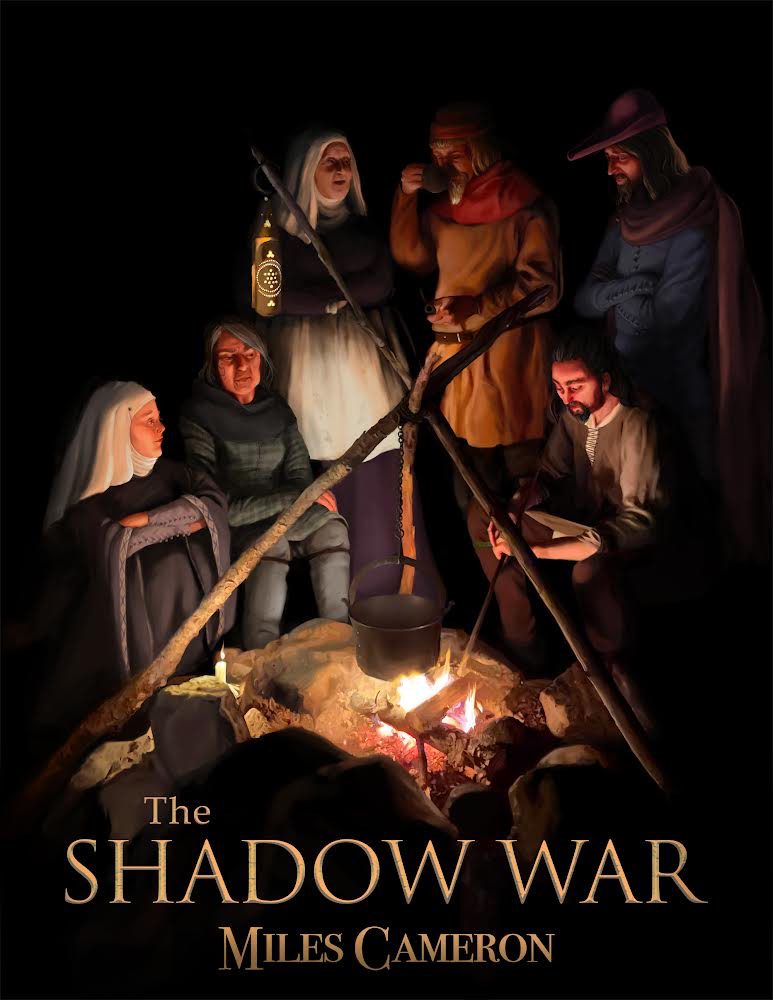I am often asked–often by readers, but occasionally by other writers–about writing fight scenes. I thought I’d write a sort of mixed book review, ‘sport’ review and writing tutorial.
The three books (really, two books and a series) are, in no particular order, Bob Charette’s brilliant Armizare, the Chivalric Martial Arts System of Il Fior di Battiglia; Guy Windsor’s carefully illustrated, easy-to-use series called ‘Mastering the Art of Arms.’ and Tom Leoni’s excellent translation of Manciolino’s Opera Nova, called The Complete Renaissance Swordsman.
First, martial arts interest me. Passionately. The martial arts that interest me were–and are– deadly–probably far more lethal than those practiced in most store-front dojos–but that’s not my interest at all. I will never (I hope) face an opponent with lethal intent while wearing 80 pounds of plate armour and wielding a spear. (BTW, the above was not a cheap shot at other martial arts. Armizare–the study of fighting in armour–comes to us by the writings and drawings of people who used them to survive on the battlefield. Most modern martial arts are the ‘sport’ descendents of such arts. Even, dare I say it, MMA, is a sport–a vicious one, but still–sport. Want to understand this better? See my review of ‘Old School’ below. IMHO all martial arts are equal–equally cultural, equally ‘valid’ and macho doesn’t interest me. I speak as the merest historian.)
I will admit that part of my interest is because fighting–well–fuels my writing. Even getting injured fuels writing–I read a critic on Amazon the other day who complained that William Gold, one of my characters, is ‘always injured’ and yet ‘keeps fighting.’ Yes, exactly. Ask any modern professional soldier. Ask any MMA fighter, or really any athlete at all. Always injured, always fighting. this little reality is as true in ballet and Olympic kayaking as in combat sports and combat itself. The sad truth is most modern people never use their bodies to the peak of endurance, so they’ve lost the understanding of what that life was and is like. Our ‘extreme’ sports are much safer than, say–farming, back before 1960. Oh, yes.
But, as is so often the case, I digress. Studying the martial arts of the past–carefully, in an academic way, with some language study–is as much a window on the soul of that era as dance, cooking, or drama. We have a touching belief. in our modern age, that war and violence is somehow ‘more efficient’ than any other human endeavor–that men about to risk their lives will eschew grace and beauty and ‘cool’ for lethal expediency. Well, some do, but many do not. If you doubt me, let me offer you the world of street racing. 🙂 Even gang wars have a sort of sick ‘cool factor’ involved. And war in the past–where you were ‘performing’ war as well as risking your life–had more of this element than the modern day. (Although, having been a back-seater in US Navy aviation, I will comment that I think some modern warriors are still hyper-aware that they are performing before their peers. But enough psycho-babble)
When you read Manciolino, my favorite early 16th century weapons master, or Fiore, to me, the greatest of all the European masters, and the first we know of, you can read into the heart of darkness in an era. You are there. When Fiore tells you that a certain strike with the pommel of the sword will make your opponent spit four teeth–when he tells you how to open visor on a helmet, and if that fails, how to spin your opponent to hit him in his–er–unarmoured’ lower regions…that’s more visceral than any amount of fantasy. He was there. These things worked. And they inform the reader at a different level than mere imagination.
Over the last thirty years, a growing community of martial arts nerds–some from the Japanese arts, some self-trained, and some from European fencing or the remarkable sport fighting world called the Society for Creative Anachronism–have dug up dozens–now hundreds–of manuscripts dating from between 1300 and 1800 and translated them to make them accessible to English readers. This has caused a revolution in the ‘sport’ of so-called ‘Western Martial Arts’ (not my favorite term) or ‘Historical European Martial Arts,’ (also not my favorite term.)
It is now possible, if you avoid the usual martial arts snake-oil salesmen (and women,) to learn pretty much exactly how a knight expected to fight, on horse or foot, with any knightly weapon, in 1385 (like William Gold). Likewise, it is now possible, in twenty or thirty hours, to get a decent grasp on how a late fifteenth-century gentleman (like Tom Swan) expected to face off bravos in the streets of Rome, or fight with a dagger in the streets of Venice. Not only can you read the books and take classes, you can buy superb recreations of the weapons, sharp for individual practice or very high level sparring (do NOT try this at home, kids) dull and rebated for experienced practitioners, and hard nylon for new students. Really–it’s amazing.
Oh, you want to look? OK, these folks make, IMHO, the best practice swords and the best live steel in the business. There are some smiths in Europe and in America who make better…but they cost three to five times as much.
Really? You came back to the blog after looking at Albion?
Right. Three things about fight scenes–maybe four.
Most importantly, I’d like to say that the very best way to understand a fight scene is by fighting. Reaching a level of skill where you can even TRY to face multiple opponents is incredibly revealing of the realities of real combat (everything goes to hell). The old manuals, and the new insights of body mechanics and traditions brought by scholars like Guy WIndsor (Finland), Sean Hayes (Oregon), Greg Mele (Chicago), Bob Charette (Virginia), Jason Smith (Ottawa), Christian Tobler (All over the USA) and Ian Brackley (Toronto) can both confound and illuminate–giving you the kind of detail on which a good scene can turn. I’ve included their school links in case you want to dash out and start taking classes. There are many other good schools, in Europe, Australia, and North America. I’ve listed the ones whose instructors I know.
Anyway…
I have caveats. There are things martial arts won’t teach you.
First caveat. In real fighting, a large, confidant, athletic person may well defeat a skilled person. It never works that way in the movies, but frankly, despite lots of mythology, superb coordination and sheer size both matter. So, while martial arts may give you some hints of how action should work, there’s no revelation like facing a big, strong kid with good reflexes and no reservations about hitting you. In novelistic terms, this should happen more often. In real life, it leads to humility. Or even injury. 🙂
Second caveat–I’m a fairly skilled swordsman, and when I fight–hard–my mind is a fair imitation of the dark mirror recommended in some Japanese arts. I’m not ‘thinking’ (in fact, I am thinking very fast, but with little conscious appreciation of what I’m about) as my body and mind read my opponent’s pressure where our edges meet, his stance, her slight tell with her back foot–all this is processed and acted on. And my life is not even actually in peril. My point here is–and I have seen real combat, with bullets–there’s a willing suspension of disbelief to a fight scene, in that we pretend that people have conscious thought and memory of events. In fact, except for a brilliant moment that my opponent or I had, or shared, in a fight–I usually have little memory of the ‘blow by blow’, unless I am the director or referee, and even then… add terror and confusion, and it is possible that no one has ever remembered any part of a real fight. Comparing historical accounts of battles would suggest this…
Let me just beat this dead horse a moment. If you go find a veteran of the recent Afghan war, or Iraq, or Korea or Vietnam–and ask them to describe a combat in which they took direct part–you will learn a great deal about people, and stress, and memory of stress. The issue as a writer is–how do you communicate that, and, like Jack Nicholson in ‘A Few Good Men’ you might ask if your readers can handle the truth…
My third caveat is for both writers and readers. The best fight scene ever written (which, in my humble view, was supremely done by Dumas) is only important to the reader if she cares. Fight scenes without character and motivation are pretty much exactly like sex scenes without character and motivation. They may titillate briefly, but they fail you as a writer. Violence has to tell a story, and move plot, and involve character, or its just the author’s wish fulfillment or fantasy of masculinity or what have you. They don’t matter. Violence itself is pretty banal, if you get past the shiny swords and the myth. Most of it is just bad. Even evil. Keep that in mind, because in adventure books, it can fascinate, like a wicked snake–or it can dominate, and that’s a different book entirely.
All of the books I listed above are excellent guides to looking at the Medieval fighting arts. All are readable, and all offer a writer–or a reader–a new insight into the portrayal of violence. All have attempted to distil complex systems with foreign names and titles into something you can comprehend.
But there’s no substitute for the doing. So if you really want to know, find a school and put in a little sweat. Even the training will give you more about which to write–or deepen your reading.
Or wreck it… I confess that the more I know about combat, the more things I find unreadable. But that’s for another day, as is my long planned blog on the martial art of commanding men (and women) in the field without modern communications–a beautiful and difficult art of its own.
And of course, if you choose to come to Greece this fall of Pen And Sword 2015… we can talk about it over Mastika. What’s mastika?
Evil laughter.






Reblogged this on parmenionbooks and commented:
Everything a reader of writer might want to know about how a fight scene is written.
An excellent collection of pointers. I was writing a (still unfinished!) book that included a fight sequence with a battle axe, and I was having real trouble developing the scene. I wrote to UK historian Mike Loades, who writes and presents articulately on ancient warfare. Mike (as you are most likely aware) breathes life into his subject by “doing”. It was while watching him conduct a display that I first learnt how exhausting fighting in plate armour could be. He graciously helped me out, and if I ever finish the book, Mike will get the first copy!
it is not really that exhausting, if it fits. I’m 52, and last fall I fought 17 opponents and acted as a judge int he lists in between–I was in harness without a break for 7 hours. I’m not a monster of fitness. I don’t no Mr. Loades, although I saw him in one video on chariots, but I am going to suspect that if he was exhausted, his armour didn’t fit well and/or he didn’t have enough experience in it.
Absolutely, Mr. Cameron. I’m working on reading all your books. Primarily because of your knowledge that goes beyond mere research. I get the feelingthat I’m there. As a kid I used to read the pulp action adventure novels. I became an adult while in the Army, and now only novels that have authenticity command my attention. I still like action novels set in modern day, but limit it to the authors who have “been there, done that”. Again thanks for your
eexcellent novels and articles.